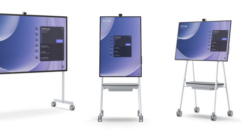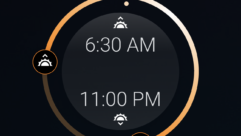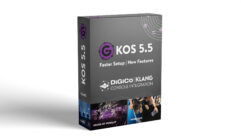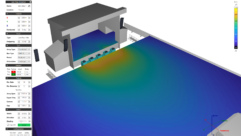
5 Things to Love about the Microsoft Surface Pro and 3 Frustrations
Feb 15, 2013 3:44 PM,
By Jason Bovberg

Like many tech-minded consumers on the weekend of Feb. 9, 2013, I found myself frustrated that my local Best Buy was woefully understocked on Microsoft’s new productivity powerhouse, the Surface Pro hybrid tablet/PC. I had preordered the device the previous week and had been told that I was high on the list. A visit to the store on launch day revealed that only one unit of the most desired version—the 128GB Surface Pro—had been received, and of course that went to the lucky individual (damn him or her!) who preordered it just before I did. I encountered several people wandering the area, inquiring about the Surface, but they were all turned away.
Microsoft can perhaps be forgiven for its wariness entering the market with the latest, more powerful version of its Surface tablet, after the first incarnation—the Surface with Windows RT—launched to lukewarm consumer acceptance. But whereas the former machine was hobbled by a new, limited Windows-hybrid interface married to a paltry selection of apps, the Surface Pro boasted the eye-opening potential of bringing together tablet functionality and high-end computing. That’s why I was eager, and fortunately, I finally ended up with my own Surface Pro a few days later (in fact, I’m writing this column on the fabled Touch Cover). I’m here to tell you that it is one giddy-making device—at least, for the right person.
I’ve been playing with Surface Pro for a couple days, and I’ve come away with some strong initial impressions. Most of these impressions are positive, but a few are undeniably negative; let’s call those last items frustrations, or areas to improve, because in most of those cases, they are certainly areas that the existing Surface Pro can improve on in its lifetime. I’ll start with my top five features and wrap up with my bottom three.

POSITIVES
1) The hybrid tablet/PC experience
The unique combination of PC and tablet is, again, the primary attraction of the Surface Pro to the power user. I wanted a computing device that would let me, under the varying circumstances of my life, either get work done or play. It’s something I’ve waited for since the dawn of the tablet computer concept years ago. I remember checking out one of the first tablet PCs at a tech conference a decade ago—it was a brick with a stylus, an impressive piece of machinery that nevertheless seemed incomplete. It was a great computer for field workers or wandering doctors, but it was missing something. That something, of course, was a sense of fun, and it took Apple and swipe gestures, gaming, and digital media to make tablets a blast and bring them to the attention of a wide audience. But Apple’s iPad is far more about fun than about productivity, and so—to me—that seemed incomplete, too. The Surface Pro solves that problem, and it is compelling. As I type this in a restaurant, I’ve devoted two-thirds of the screen to the writing of this article in Microsoft Word, and the other third to a Netflix stream of a concert video. This capability nicely illustrates the hybrid nature of this new kind of device—a decidedly connected or converged experience. Plus, there’s the simple ability to use Surface Pro for different purposes at different times. I can mindlessly game on its slick surface at night, and I can build intensive spreadsheets in Excel the next morning.

2) The accessories
Removing Surface Pro from its box, you can’t help but notice that it has come with a stylus (reminding me of the best feature of those early tablets). And once you start playing around with the stylus, you realize that it’s no ordinary digital pen. Based on Wacom technology, the stylus supports 1,024 levels of pressure sensitivity, and even uncalibrated out of the box it is remarkably subtle and effective. Downloading the Fresh Paint app gave me an opportunity to test the precision of the stylus as an artist’s tool. I ain’t no artist—far from it—but even I could appreciate the capability. It took handing the pen to a graphic designer to see its full impact. Yes, even a devoted Apple fanboy lifted his eyebrows in appreciation. But clearly the greatest accessories supporting the Surface Pro are the Touch and Type covers—those detachable covers that are unfortunately not included in the purchase price but are absolutely necessary for the full Surface experience. As I mentioned, I started typing this review on the Touch Cover, and just now I switched to the Type Cover. They’re both fantastic. Obviously, they both have a smaller form factor than a typical laptop, so you have to adjust your expectations—and if you have giant hands, you also have to get ready to be a bit cramped. But I have fairly large hands, and the keyboards are still very comfortable. The Type Cover has an excellent tactile response, but the Touch Cover is the revelatory one. With barely any discernible key contours or edges, it seems at first glance to be a cheap, colorful cardboard slate, but in reality it’s a spectacularly responsive tech marvel that has a surprisingly quick learning curve. Although I’ll be more comfortable typing long-form work on the Type Cover, it’s the Touch Cover that makes me happier, and quick typing on it is undeniably fun.
3) The performance
This is a fast machine. Essentially a high-end Ultrabook, the Surface Pro comes with a 1.7GHz Core i5 CPU, 4GB of RAM, and—on my device—a 128GB SSD drive, as well as an integrated Intel HD Graphics 4000 card. Swiping across the Windows 8 tablet interface produced no discernible lag, and that’s across the stunning 1920×1080 screen. It is powerful as well as power-hungry, and that’s the primary reason why Surface is a Wi-Fi-only device (no 3G or LTE capability yet). After all, with great power comes great power demands. In my experience, I can get Wi-Fi where I want it, for the most part, and that situation is improving all the time. So I have no problem with that compromise. Battery life is another issue—and I cover that later in this article. But at home and at trusted Wi-Fi environments, Surface Pro is a responsive beast, and of course all my productivity work occurs without a hitch.
4) The customizability/personalization options
Now we come to the controversial UI backbone of the Surface Pro, and that is the Windows 8 OS. It is with great misfortune that Windows 8 rushed out onto the market on mostly non-touch-based displays because this is not an OS that works well on traditional monitors. Most people would say, in fact, that the experience “sucks.” That it’s disastrous. To a certain extent, I agree: Outside touch, Windows 8 is a head-scratcher. Microsoft now faces the tough challenge of reintroducing an extremely wary public to its new OS, and it’s devices like this that are going to help. Windows 8 smokes on the Surface Pro: It’s an almost exhilarating experience to dive in to the OS and make it yours. Much like the Windows Phone UI, the Windows 8 UI is infinitely customizable. One of the first things I did after opening the box was download some favorite essential apps (e.g., Kindle, Netflix, assorted games) from the app store, and begin organizing them to my liking across the brilliantly colorful, swipeable Start screen. As you build your collection of apps and pinned websites and personal data, you can group like-minded items and name the groups whatever you want. If you’re as weary as I am of the aging whack-a-mole iOS and Android interfaces all over the place, Windows 8 (and the aforementioned Windows Phone, for that matter) offers something entirely new.
5) The screen
One of the things I really like about the Surface Pro’s display is that is has gone widescreen. I’m a 1.85:1 aspect ratio dude from way back (thanks to my love of film), and to see this device take its cue from that world is quite gratifying. You might be accustomed to an iPad or other tablet screen that is more at home in portrait mode, but the Surface Pro provides an experience that is best enjoyed in landscape mode—ideal for watching media and also, of course, using the device as a laptop (which it is). As mentioned, this is a 1920×1080 screen, a significant upgrade from the Surface RT’s 1366×768 resolution. The difference gives you a more vivid, detailed screen, and at 10.6in., it’s nearly a full inch larger than the iPad screen—again, at a slightly different (and to me, more pleasing-to-the-eye) ratio. That extra real estate will be necessary, because don’t forget: This is no laptop screen. It is necessarily small, and sometimes text and icons can be on the edge of readability. It also struggles outdoors, as most glossy tablets do. But in my work environment, the Surface screen strikes a perfect balance between size and usability. One caveat to keep in mind is that the Surface—so far—doesn’t seem to be playing well when scaling to external displays. Translated to much larger displays, the Surface display’s small icons become comically large, and you need to adjust the configuration to create a workable desktop. Microsoft is reportedly working on that fix. And on that note…
AREAS FOR IMPROVEMENT
1) Battery life
It’s tough. And that’s coming from someone who completely understands the hardware compromises inherent in creating a device that combines a tablet experience with that of a powerful productivity PC. I mean, you get that, right? Although I’ve listed “performance” in my list of positives up there, that all comes with a necessary power penalty. I’m finding that I can say that over and over again, and I can try to forgive, but the fact is, I need to plug this thing in too often. This is an essential area of improvement—and, interestingly, it seems that Microsoft is already on the case, and not just for future incarnations of Surface Pro, but for this one. Surface GM Panos Panay and his team recently addressed this issue, and although they downplayed the problem (indeed, comparisons with similarly powered devices show that the Surface Pro falls right in line), they also dropped some significant hints that battery life might be dealt with by way of an add-on accessory—there are some mysterious high-current connectors on the back of Surface Pro. Stay tuned on that.
2) Limited app availability
Wandering around the Microsoft app store, you’ll find plenty of great apps, but there’s just no getting around the fact that the selection pales in comparison with the app stores that Google and Apple users enjoy. Frustratingly late to the game in this department, in both Windows 8 and Windows Phone, Microsoft is just watching from the sidelines while the world standardizes on those other app stores. Grocery stores, entertainment outlets, and sports teams offer specialized apps only for those development environments, and the convenience factor of those scenarios translates to untold millions of potential users. My wife counts certain apps for the very reason why she simply won’t even consider a Windows Phone. The same problem plagues Windows 8—at least for now. Today, I find myself aggravated that my Surface doesn’t yet have, for example, an official Facebook app. Facebook! Nor does it have an IMDB app (essential for this movie fan), even though Windows Phone does offer one. These kinds of missing apps speak to an inconsistent and oddly sluggish development environment. The good news is that this particular area of improvement is poised to improve quickly and daily. (Another note here: BlueStreaks recently released a Windows 8 app that allows users access to the entire Android app environment, but in my experience, the interface leaves a lot to be desired. Plus, as mentioned elsewhere, a stop-gap solution like this is not in Microsoft’s best interest. Windows 8 needs its own strong development arena in order to succeed.)
3) Windows 8
Yes, I know I talked about Windows 8 above, in the “positives” section. This is by design. Because I think of Windows 8 as a brilliant v.1 stab at a new kind of touch UI, but it’s not perfect, even on the device that provides its purest, most exciting expression: the Surface Pro. Some of the swipe gestures are unintuitive—I can imagine beginning users especially being flummoxed. Also, some of the gestures that are smart in theory are prone to disobey your fingers. Look, I am a fan of the tiles-based interface, and have been since I first stepped into the world of Windows Phone, but I also have to knock Microsoft for not making the tiles convergence more cohesive between the phone OS and Windows 8. These are two different development teams doing similar design work, but they remain separate. The interface looks different (although they echo each other), and there are many apps I can get in Windows Phone that aren’t available in Windows 8. That shouldn’t be the case. My tech dream remains a converged Windows ecosystem. Microsoft has made great strides toward that recently, including in Windows 8, but the situation could definitely improve.
FINAL THOUGHTS
I’ve shared five positives and three negatives, indicating that—for me—the good outweighs the not-so-good. I’m optimistic that some of my strongest negative feelings can be lifted not in the next iteration of Surface Pro, but in this one. Which is promising not only because it’s an expensive device that I’d rather not have to replace within a year or two, but also because Microsoft has made it clear with its early transparency on Surface Pro that it wants to get this right. It wants to get a lot right. I admire the company for making the leaps it has in the past year on behalf of users like me. Now, if you’ll excuse me, I’m finished writing this article and am ready to enjoy a little Netflix streaming.










